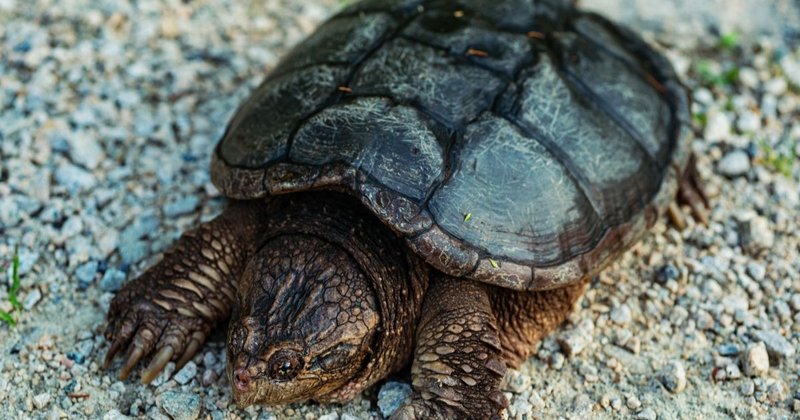
Imagine you’re out for a stroll, and you see a turtle basking on a log. You might think it’s just another turtle. However, snapping turtles have some unique traits that set them apart from their more docile cousins. Let’s dive into the world of snapping turtles and explore how to spot one in its natural habitat.
Physical Features of Snapping Turtles
To identify a snapping turtle, you first need to know what they look like. These turtles are quite distinctive. Adults can weigh anywhere from 10 to 40 pounds, and some can grow even larger. Their shells are rough and serrated, often with a dark, muddy brown or greenish color. The texture is like a well-worn piece of rock, making them blend seamlessly with their environment.
One of the most striking features of snapping turtles is their head. It’s large, with a beak-like jaw that can deliver a seriously powerful bite. You might notice their eyes protruding slightly, giving them a watchful look. And let’s not forget about their long tails, which can be almost as long as their shells! When you see a turtle with a bulky body and a rugged, spiky shell, you’re likely looking at a snapping turtle.
Habitat and Behavior
Snapping turtles love water, but they are quite adaptable. You’ll often find them in freshwater habitats like ponds, lakes, and rivers. They prefer slow-moving water where they can hide among plants and debris. Picture a serene pond filled with lily pads—this could be home for a snapping turtle.
In terms of behavior, snapping turtles are primarily nocturnal. This means they do most of their exploring and feeding at night. If you’re out during the day, they might be basking on a log or hidden under the mud. Snapping turtles are also known for their aggressive nature. If disturbed, they won’t hesitate to snap at anything that comes too close. So, if you’re trying to identify one, keep a safe distance while observing!
Listening for Their Calls
You might be surprised to learn that snapping turtles are vocal creatures. They don’t have the sweet songs of birds, but they can make some interesting sounds. If you’re near water and hear a series of raspy grunts or hisses, you could be in the presence of a snapping turtle.
These sounds usually occur during mating season or when they feel threatened. Think of it like a warning call—the turtle is letting you know you’ve entered their territory. So, if you hear these noises, take a pause and look around. You might just spot the turtle making those sounds!
Time of Year and Activity
The time of year can significantly influence your chances of spotting a snapping turtle. During the spring and early summer, these turtles are particularly active as they come out of hibernation to bask in the sun and search for food. It’s nesting season, and you might even see females digging holes in sandy or muddy areas to lay their eggs.
In the autumn, you’ll find them preparing for winter. They’ll often head for deeper waters to hibernate, so you might see fewer snapping turtles as the weather turns cold. If you want to increase your chances of seeing one, spring and early summer are the best times for snapping turtle spotting.
Common Misconceptions
You might think that all turtles are slow and easy to handle, but snapping turtles are a different story. They can be quite fast in the water and can lunge if they feel threatened. This is why they have a reputation for being aggressive. It’s essential to know this when trying to identify them, whether you’re a curious naturalist or just a hiker enjoying a day outdoors.
Another misconception is that snapping turtles can be mistaken for other types of turtles. While they do look somewhat like softshell turtles, snapping turtles have that rugged shell and a more formidable appearance. If you see a turtle with a long tail and a strong, spiky shell, chances are it’s a snapping turtle and not a softshell.
Protecting Snapping Turtles in the Wild
As you learn about snapping turtles, it’s crucial to remember the importance of protecting them. Many species are facing threats from habitat loss and pollution. If you come across a snapping turtle, observe it from a distance and avoid moving it, as they are best left in their natural environment.
You might wonder why protecting these turtles matters. Snapping turtles are essential to their ecosystems, helping control fish and amphibian populations. They also contribute to the health of aquatic environments. By respecting their space and encouraging others to do the same, you’re helping to preserve the beauty of nature for future generations.
Identifying a snapping turtle in the wild can be a thrilling experience. With their unique physical features, dynamic behaviors, and habitats, these creatures are truly remarkable. Remember to look for those rough shells, sizable heads, and distinctive tail shapes. And if you hear those raspy calls, pay attention!
When you’re out exploring, take a moment to appreciate these ancient reptiles. They’ve been around for millions of years, and spotting one is a reminder of the wonders of nature. So grab your binoculars, head to your favorite waterway, and keep your eyes open—you might just encounter a snapping turtle!

